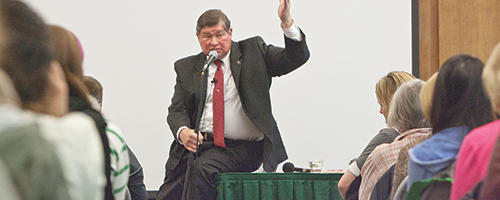On Wednesday, students, faculty members and concerned community members gathered at Portland State for a moderated discussion about whistle-blowing and issues of safety at the U.S. Department of Energy’s Hanford Site.
American Whistleblower Tour makes a stop at PSU
[portfolio_slideshow id=51058]
On Wednesday, students, faculty members and concerned community members gathered at Portland State for a moderated discussion about whistle-blowing and issues of safety at the U.S. Department of Energy’s Hanford Site.
The Hanford Site is a nuclear production facility on the Columbia River in Washington State. Established in 1943 as part of the Manhattan Project, the site manufactured the plutonium used in the first nuclear bomb test at the Trinity Site and in the Fat Man atomic bomb that was dropped on Nagasaki, Japan, in World War II.
Now mostly decommissioned, the facility serves as a central nuclear waste storage facility.
The day’s event was part of the American Whistleblower Tour, presented by the Government Accountability Project, a whistle-blowing protection and advocacy nonprofit organization. The tour brings speakers to the nation’s universities to teach the future workforce about whistle-blowing and the necessary role it plays in creating a safe and accountable government and workplace.
“This is a special tour,” said Dana Gold, a GAP senior fellow and the director of the tour, who moderated the presentation. “We’re doing a deeper dive on Hanford.
“Hanford is the leading example of how whistle-blowers can make a difference, turning information into power,” Gold added.
There are the two main reasons people don’t come forward, Gold said. People fear retaliation or are concerned that speaking up won’t make a difference.
Dr. Walt Tamosaitis learned the challenges that come with whistle-blowing first-hand. Tamosaitis was the research and technology manager at Hanford from 2003 to 2010, where he was in charge of directing a team with a $500 million budget to work on the technical design of the site’s waste treatment plant.
The plant would treat and transform nearly 53 million gallons of radioactive nuclear waste to be suitable for permanent storage.
During the course of his work, Tamosaitis discovered a flaw in the mixing process of the waste’s treatment, one that could lead to a devastating and possibly fatal accident. When he took his concerns to his superiors, they did nothing. After he persisted, he was fired and escorted from the building.
“I was surprised because I didn’t think they would do that. The last thing on my mind was that they were going to fire me for raising an issue,” Tamosaitis said.
“I was just doing my job in raising a technical issue. But they weren’t interested in my opinion.”
Tamosaitis has since gained national attention for both the severity of his claims and the retaliation against him. He testified before Congress, bringing the story to national attention, and it was broadcast nationally and worldwide.
Tamosaitis and other whistle-blowers have been essential in bringing critical safety concerns into public view, said Tom Carpenter, the executive director of the Hanford Challenge, an organization that works to protect and advocate for workers at the Hanford facility and to educate the public on the issues of nuclear waste and storage.
“Whistle-blowers are very important to us,” Carpenter said. Whistle-blowers are “the main source of credible information on problems at Hanford. We need them if we want safe and effective cleanup at Hanford.”
The waste treatment plant is not yet operating; there are still many safety obstacles to overcome. Currently, the nuclear waste on site is being stored in carbon steel tanks, which were designed to be temporary holding vessels, he said.
Storage tanks holding waste at Hanford come in two types: single-shelled and double-shelled. The single-shelled tanks were built in the 1940s and were only designed to last for 20 years. The double-shelled tanks, built in the 1970s and ’80s, were also made to last for 20 years, Carpenter said.
“These tanks are in trouble. Half have failed and…leaked half a million gallons of waste.” They’re still leaking right now, he added.
Leaks from the storage tanks go straight into the soil. From there, the nuclear waste gets into the groundwater, which goes to the river. With Hanford only 250 miles upstream from Portland, this poses severe risks, Carpenter said.
Now, 56 million gallons of highly radioactive nuclear waste is being stored at the Hanford facility—but it’s not the amount that’s the problem, Carpenter said.
“It’s not the volume; it’s what’s in the waste. It’s a very toxic, concentrated brew. How dangerous is it? So radioactive that the amount that can fit on the leg of a fruit fly is extremely dangerous,” he said.
“Tank storage is a temporary solution. Waste is dynamic. You can’t walk away from nuclear waste. It’s a bad idea to have liquid waste and put it in a tank outside. We need to solidify it and put it away…from water,” Carpenter said.
“We have to get the waste out of the tanks. No piece of carbon steel can last forever. It will crack. It will erode. You’re just not going to stop it,” Tamosaitis said.
While safety concerns about the site have been raised, progress finding solutions has been slow.
“We urge people to communicate with Congress. They aren’t sold on this issue,” Carpenter said. “It’s an urgent, urgent issue.”
The panel stressed that the status of Hanford and other potential areas of safety concern can be influenced by the people and future whistle-blowers.
“Younger people will really shape the country as we go forward. I encourage you to think of your values,” Tamosaitis said.
“You want to look back and say, ‘I did the right thing.’ What are your values? What do you stand for? Start thinking about [that] today,” Tamosaitis said.



